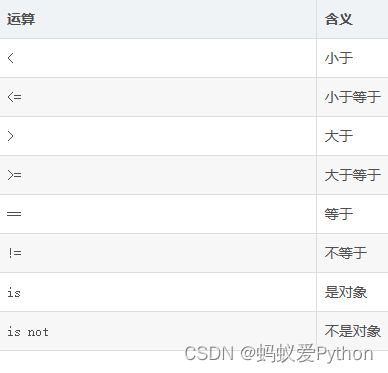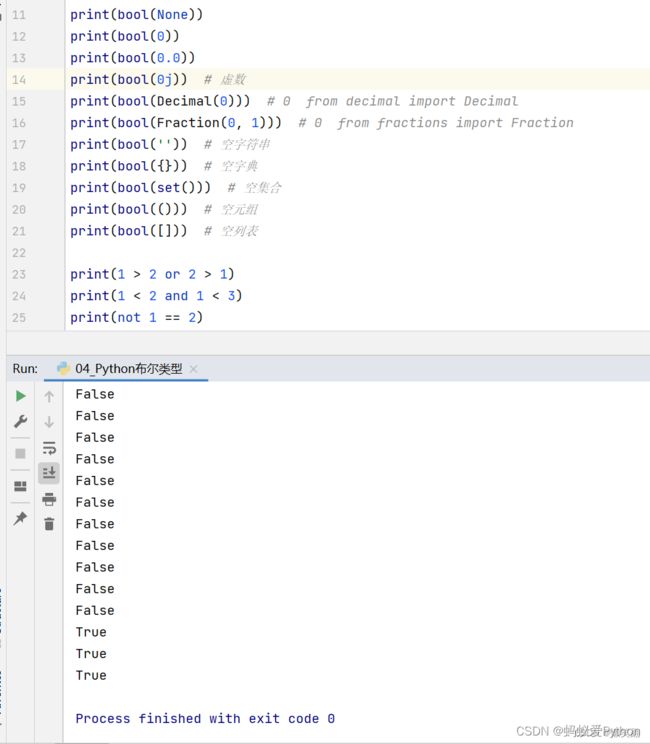Python bool 到底怎么用? 【源码拆解】
人生苦短 我用python
一、布尔类型描述
布尔类型是计算机中最基本的类型,
它是计算机二进制世界的体现,一切都是 0 和 1 。
Python中的布尔类型只有两种值:True 和 False 。
(注意:首字母都是大写,与
C++、JavaScript中的小写有所不同)
布尔类型回答的是 是非 问题,
那么什么情况下是 True ,
什么情况下是 False 呢?
Python里面实现了一个 类型对象 叫做 bool ,
bool是一个 int 的子类,
内置的 True 和 False 就是bool仅有的两个实例对象。
python 中布尔值使用常量 True 和 False来表示;
注意 T F 大小写
bool 是 int 的子类(继承 int ),
故 True == 1 False == 0 是会返回 Ture
bool 类型只有两种状态真或假
使用bool我们就可以对对象进行布尔真假判断:
为假的情况有:
print(bool(None))#python源码籽料:903971231 ### 源码领取
print(bool(0))
print(bool(0.0))
print(bool(0j)) # 虚数
print(bool(Decimal(0))) # 0 from decimal import Decimal
print(bool(Fraction(0, 1))) # 0 from fractions import Fraction
print(bool('')) # 空字符串
print(bool({})) # 空字典
print(bool(set())) # 空集合
print(bool(())) # 空元组
print(bool([])) # 空列表
二、布尔运算
优先级:not > and >or
(1) or是一种“短路运算符”,只有当第一个为False时才去验证第二个。即:两个变量只要有一个为True则为True。
(2) and 也是种“短路运算符”,只有当第一个为True时才去验证第二个。即:两个变量都为True时结果才为True。
(3) not 的优先级比非布尔运算符底,所以 not a == b 解释为 not (a == b) ,并且 a == not b 是语法错误。
print(1 > 2 or 2 > 1)
print(1 < 2 and 1 < 3)
print(not 1 == 2)
三、比较运算
前面提到,
布尔值反应的是“是非”,
有比较才有是非。
Python中有8中比较运算。
它们有相同的优先级,
比布尔运算的优先级高。
比较运算符可以任意的连写,
比如: x < y <=z 相当于 x < y and y <= z 。
四、总结
布尔类型(True, False)表示“是非”,
是比较运算的结果,
是条件判断的结果,
从而决定程序的流程和分支走向。
默认情况下,
所有类型都可以转化为布尔类型
from decimal import Decimal
from fractions import Fraction
print(bool(None))
print(bool(0))
print(bool(0.0))
print(bool(0j)) # 虚数
print(bool(Decimal(0))) # 0 from decimal import Decimal
print(bool(Fraction(0, 1))) # 0 from fractions import Fraction
print(bool('')) # 空字符串
print(bool({})) # 空字典
print(bool(set())) # 空集合
print(bool(())) # 空元组
print(bool([])) # 空列表
print(1 > 2 or 2 > 1)
print(1 < 2 and 1 < 3)
print(not 1 == 2)
五、源码
bool(x) -> bool
Returns True when the argument x is true, False otherwise.
The builtins True and False are the only two instances of the class bool.
The class bool is a subclass of the class int, and cannot be subclassed.
class bool(int):python源码籽料:903971231 ### 源码领取
"""
bool(x) -> bool
Returns True when the argument x is true, False otherwise.
The builtins True and False are the only two instances of the class bool.
The class bool is a subclass of the class int, and cannot be subclassed.
"""
def __and__(self, *args, **kwargs): # real signature unknown
""" Return self&value. """
pass
def __init__(self, x): # real signature unknown; restored from __doc__
pass
@staticmethod # known case of __new__
def __new__(*args, **kwargs): # real signature unknown
""" Create and return a new object. See help(type) for accurate signature. """
pass
def __or__(self, *args, **kwargs): # real signature unknown
""" Return self|value. """
pass
def __rand__(self, *args, **kwargs): # real signature unknown
""" Return value&self. """
pass
def __repr__(self, *args, **kwargs): # real signature unknown
""" Return repr(self). """
pass
def __ror__(self, *args, **kwargs): # real signature unknown
""" Return value|self. """
pass
def __rxor__(self, *args, **kwargs): # real signature unknown
""" Return value^self. """
pass
def __xor__(self, *args, **kwargs): # real signature unknown
""" Return self^value. """
pass






